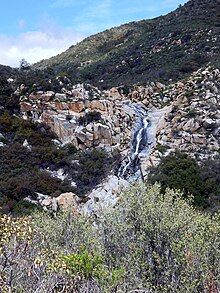Tenaja


A tenaja or tinaja is a water basin or retention area. The term usually implies a natural or geologic cistern in rock which retains water. They are often created by erosional processes within intermittent streams.
Before European settlers came to America, tenajas were a valuable source of water for early Native Americans traveling in the desert areas of the Southwest. Today, tenajas are an integral part of sustaining life in the arid Southwest. For example, tenajas at the Santa Rosa Plateau in southern California allow western pond turtles, California newts and red-legged frogs to survive through dry summer months.[1]
During prolonged dry spells, deep tinajas may trap desert animals who cannot climb out due to the smooth walls.[2][3][4]
Etymology
From the Spanish tinaja: a clay pot or earthenware jar.[5]
List of tenajas
- Tenaja Canyon Creek, Cleveland National Forest, California, USA[6][7][8]
- Ernst Tinaja, Big Bend National Park, Texas, USA[2][3][4]
- Santa Rosa Plateau Wildlife Area, Riverside County, California, USA[1][9]
References
- ^ a b "Plants | RiversideCountyParks.org". www.riversidecountyparks.org. Archived from the original on 2009-05-08.
- ^ a b "Ernst Tinaja (U.S. National Park Service)". www.nps.gov. Retrieved 2021-05-08.
- ^ a b "Ernst Tinaja, Big Bend National Park". www.texasescapes.com. Retrieved 2021-05-08.
- ^ a b "Big Bend Virtual Field Trip - Ernst Tinaja". prism-redfern.org. Retrieved 2021-05-08.
- ^ "Check out the translation for "tinaja" on SpanishDict!". SpanishDict. Retrieved 2021-05-08.
- ^ "GNIS Detail - Tenaja Canyon". geonames.usgs.gov. Retrieved 2021-05-08.
- ^ "Cleveland National Forest - San Mateo Canyon Trail (5W05)". Fs.usda.gov. Retrieved 2022-09-17.
- ^ "Tenaja Canyon". Modern Hiker. 19 March 2018. Retrieved 2021-05-08.
- ^ "SANTA ROSA PLATEAU WILDLIFE AREA". RivCoParks. Retrieved 2021-05-08.
